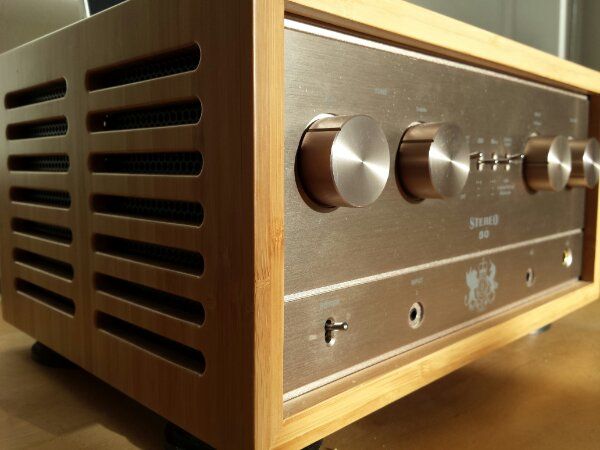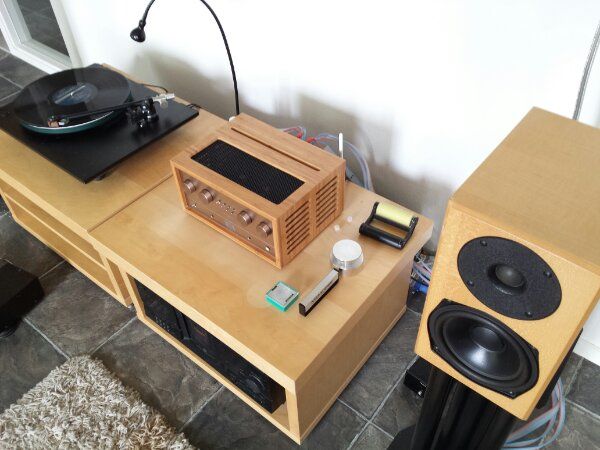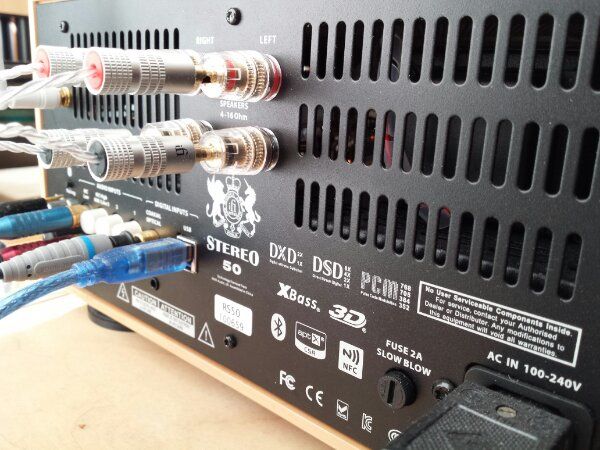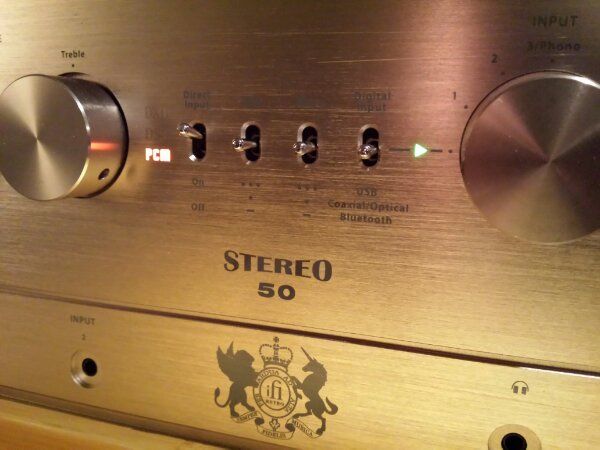-
You are using an out of date browser. It may not display this or other websites correctly.
You should upgrade or use an alternative browser.
You should upgrade or use an alternative browser.
iFi Retro Stereo50
- Added by XjunkieNL
- Create date
-
- Tags
- ifi-retro-stereo50
magig160
New Head-Fier
View previous replies…
ostewart
iFi support is excellent, they will sort you out unless it is user damage. Even then they should be able to help, there are stories where they have replaced stuff even if it's just out of warranty. This "review" is very badly worded and no one can understand your issue...
Liam2
As I said in the forum, where you brought this up, it doesn't correspond with my experience at all. I find both iFi and AMR to be fully supportive of their products and in response to any technical queries.
Koolpep
Obvisouly this has nothing to do with a review - this is a bad customer service experience, I totally agree and should be sorted. But this is supposed to be a review.
XjunkieNL
New Head-Fier
Pros: Sweet pure natural sounding amplifier that successfully combines old and new technologies and offers an extravaganza of music sources to listen to
Cons: it's hard to think of cons with this kind of performance and high value for money
Early 2015 I was looking on the iFi website for info on the iPhono. This is when I discovered the iFi Retro Stereo50. What is this? What do all these icons and logos mean? Is this really an all-in-one amplifier? How does it sound?
I found limited info while googling for more information on this amplifier. This was two weeks before the official introduction at the UK Bristol Hi-Fi show. What caught my attention was the combination of analog and digital technology. Old versus new. Besides the info I found on iFi’s own website, I learned that the amplifier was designed by Thorsten Loesch. This was the little push I needed to go for it.
A few days later a big box arrived at my doorstep. After unpacking the unit, I could immediately hear Dee-dee of Dexter Laboratory say her catch-phrase "Oooooooh, what does this button do?". So many buttons and switches. Cool! The overall finish is excellent. The cover gives you a peek at the tubes. My first tube amplifier.

First thing I tried was to start the radio from my telephone. After switching on the amplifier you first see a red flashing status LED on the front panel, indicating the warm-up time. This takes about 45 seconds.Select digital input as a source, select Blue-tooth as a digital input switch. I didn’t get a connection right away, the included blue-tooth antenna needs to be mounted. Pairing is also possible with NFC. Next I started the radio app on my phone and choose a radio station. Wow, it works, music comes from the speakers. The blue-tooth connection uses AptX audio coding which enables CD like quality.
With the amplifier comes a box with accessories. Besides a remote control, USB cable, RCA interlink, mini jack cable, TOS link adaptor also some loudspeaker cables are included. Especially the loudspeaker cables are nice. They are in Teflon isolated silver plated copper cables, fitted with Z-plugs and are 2 meters in length. I used them to replace my current cables.

Now it’s time to connect my analog gear. Vinyl is my main source for music. First thing I noticed was how empty my audio rack looks now. The iFi Stereo 50 is a small unit and with my phono preamp and some of the interconnects gone, it leaves a lot of clear space. My cartridge, a Denon DL-103, needs to be connected to the MC low input. Also the mode switch on the back panel needs to be set to MC low. The amplification of the phono MC stage is 62 dB, enough to bring the 0,3 mV output of the cartridge to the required level. Time to take a LP out of his jacket and placing it on the turntable. The fun can start.
The iFi Retro Stereo 50 replaces a Rega Brio integrated amplifier with a DIY tube phono preamp (design by Thorsten Loesch). The sound of my old system is very close to how Rega called its amplifier: Brio. The Stereo 50 sounds more detailed, faster and more natural. If I needed to rename the iFi amplifier it would be iFi Baileys. The music it makes is fluid, smooth and creamy. Very attractive.
I can’t help it, but have to play with the dials and switches. All of them have a nice quality feel to them. I begin with the 3D Holographic switch. This creates a wider and deeper sound stage. The amplifier has two version incorporated, one for head phones and one for speakers. This is selected automatically and depending on what is connected. In my case Totem Mite speakers. The way it increases the sound stage beyond my speakers is subtle. The music also seems to curve a little; the centre moves a little deeper. Since switching it on for the first time, it never has been switched off. A nice side effect is when I’m not direct in front of the speakers, it keeps the image of the music coming from a stage situated between the speakers.

Xbass is a practical feature when using small speakers with a limited low frequency range. In principal it can’t extend the low frequency. To my ears it has. You can select three settings. One is off. Sometimes I choose to switch it off, this happens when a radio station sounds boomy. Most of the time I have selected the middle setting. It feels as if Xbass and 3D Holographic are working together. Together they give a wonderful full presentation of the sound coming from my mini speakers. These two features give the possibility to put your speakers in a less obstructive spots. But I couldn’t resist moving them around to give them more breathing space.
With the phono input selected you have the possibility to choose different phono equalisation curves. There is no clear guideline when to choose which specific EQ curve. As I understand it, it depends on many factors such as year of release, label and land of origin. As a vinyl junkie with many second hand records from the seventies, I was intrigued by this feature. Although the amplifier is in general “plug in and forget”. This is something you have to play with. For me the direct input switch becomes a bit of an undocumented EQ switch. With it I switch for example easily between the selected Decca EQ and the standard RIAA EQ curve. More than ones the Decca EQ made the record sound less bright and gave it more body. In the short time I have owned this amplifier I grew fond of this feature and would miss it if it was removed.

The tubes in the amplifier are the EL84X. These have a little higher output as standard EL84 and give, according to the specs, a total power output of 2x 25W. This is enough to fill my 35 square metre living room with music. With my speakers it doesn't do party loud. If you want to use NOS EL84’s this is possible, you just remove the jumper on the main PCB marked EL84X. A nice glow of the tubes is visible when switched on.
My carousel CD player does not make many hours the last few years. Connected to the Stereo50, it sounded nicer as I remember. This was with the analog line output of the CD player connected to the audio line in. To be able to use the DAC chip in the amplifier I bought an optical cable to use the optical SPDIF input. Boy, was I in for a surprise. The amplifier made the CD sound as I had not heard before in my system. A lot of the things I thought were specific for vinyl playback, I was now hearing from a digital source. Fluid and smooth was the music created by the iFi Baileys.

Owning the Stereo 50 gives a special feeling. The way it looks, the many sources it accepts, the glow of the tubes, the way it sounds. It makes me feel I will own this unit for a long time. At the moment I often use it to listen to the radio. An old Ipad1 is used as a radio connected to the USB port. The top of the Retro50 has a convenient groove, which holds the Ipad nicely. Over time I learned it is best to switch on the amplifier first and the Ipad second. The communication does not always work when switching everything on in the opposite way. This is also true for a bluetooth connection.
The iFi website mentions a study done on the effects of adding tubes to your hifi system. With the Stereo50 I feel I was part of the study and belong to the group where the music invites you to listen longer and influenced your movements such as tapping your feet. I am enjoying my music independent if it is coming from a LP, CD or radio. The amplifier is my introduction to tubes. As I understand no maintenance is needed. Although they are fragile and care needs to be taken. During transport my first set of tubes were damaged and I got crackling popping sounds from the speakers. After replacement all was well again.

My experience with the after sales service offered by iFi is very positive. Communication is fast. And always helpful. As an owner of one of the first units I’ve seen some teething problems. Most of them are minor. For example a very bright LED has been dimmed. A soft ticking power supply has been quieted down. An error message I still get on my Ipad is “Cannot Use Device: The connected USB device requires too much power.”, when the Stereo50 is switched off. This can be solved with a combined USB hub, but this will drain the battery of the Ipad.
The unit can handle different high resolution formats such as PCM, DXD and DSD via USB. The front panel indicates with coloured LEDs the format and sampling rate of the incoming signal. Unfortunately I have no experience with high resolutions streams and can’t say much about it. I’m curious how for example the 192 kHz format will sound as this is sometimes used as a master for remastered vinyl. A whole new world is there to be discovered. But till now no PC has been connected. Also no head phone has been connected. The possibilities and features are almost unlimited. It can handle and do almost everything.

Something that has puzzled me, is how to describe the sound of the Stereo50. There is something magical in how it sounds. Independ of the source. Does it colour the sound? No. Is it natural? Yes. Is it super detailed? No. But somehow it attracts your attention, because the music it makes sounds beautiful. There is definitely a sweetness in the sound. Not to be mistaken with warmth. The best way I can discribe the sound, the Stereo50 brings out the beauty of the music being played.
I've owned the amplifier since the beginning of February 2015. Most of the listening was done with my analog source. The amp is very well balanced. You notice this with everything. It is a well thought out all-in-one concept. Everything is not just added and put on top of each other, which maybe would have doubled its price. It is integrated in the real sense of the word. The end result is a very beautiful, sweet pure natural sounding amplifier that successfully combines old and new technologies and offers an extravaganza of music sources to listen to.
Addendum:
For those interested I posted a video on YouTube giving an overview of the functions and capabilities of the iFi Retro.
I share my experiences over the last one an a half year.
Compared to other reviews focus is a little more on vinyl playback.
The unit is also opened up to have a look inside and have a peek at the EL84 tubes.
[VIDEO]https://youtu.be/VieWFfgXqMc[/VIDEO]
I found limited info while googling for more information on this amplifier. This was two weeks before the official introduction at the UK Bristol Hi-Fi show. What caught my attention was the combination of analog and digital technology. Old versus new. Besides the info I found on iFi’s own website, I learned that the amplifier was designed by Thorsten Loesch. This was the little push I needed to go for it.
A few days later a big box arrived at my doorstep. After unpacking the unit, I could immediately hear Dee-dee of Dexter Laboratory say her catch-phrase "Oooooooh, what does this button do?". So many buttons and switches. Cool! The overall finish is excellent. The cover gives you a peek at the tubes. My first tube amplifier.

First thing I tried was to start the radio from my telephone. After switching on the amplifier you first see a red flashing status LED on the front panel, indicating the warm-up time. This takes about 45 seconds.Select digital input as a source, select Blue-tooth as a digital input switch. I didn’t get a connection right away, the included blue-tooth antenna needs to be mounted. Pairing is also possible with NFC. Next I started the radio app on my phone and choose a radio station. Wow, it works, music comes from the speakers. The blue-tooth connection uses AptX audio coding which enables CD like quality.
With the amplifier comes a box with accessories. Besides a remote control, USB cable, RCA interlink, mini jack cable, TOS link adaptor also some loudspeaker cables are included. Especially the loudspeaker cables are nice. They are in Teflon isolated silver plated copper cables, fitted with Z-plugs and are 2 meters in length. I used them to replace my current cables.

Now it’s time to connect my analog gear. Vinyl is my main source for music. First thing I noticed was how empty my audio rack looks now. The iFi Stereo 50 is a small unit and with my phono preamp and some of the interconnects gone, it leaves a lot of clear space. My cartridge, a Denon DL-103, needs to be connected to the MC low input. Also the mode switch on the back panel needs to be set to MC low. The amplification of the phono MC stage is 62 dB, enough to bring the 0,3 mV output of the cartridge to the required level. Time to take a LP out of his jacket and placing it on the turntable. The fun can start.
The iFi Retro Stereo 50 replaces a Rega Brio integrated amplifier with a DIY tube phono preamp (design by Thorsten Loesch). The sound of my old system is very close to how Rega called its amplifier: Brio. The Stereo 50 sounds more detailed, faster and more natural. If I needed to rename the iFi amplifier it would be iFi Baileys. The music it makes is fluid, smooth and creamy. Very attractive.
I can’t help it, but have to play with the dials and switches. All of them have a nice quality feel to them. I begin with the 3D Holographic switch. This creates a wider and deeper sound stage. The amplifier has two version incorporated, one for head phones and one for speakers. This is selected automatically and depending on what is connected. In my case Totem Mite speakers. The way it increases the sound stage beyond my speakers is subtle. The music also seems to curve a little; the centre moves a little deeper. Since switching it on for the first time, it never has been switched off. A nice side effect is when I’m not direct in front of the speakers, it keeps the image of the music coming from a stage situated between the speakers.

Xbass is a practical feature when using small speakers with a limited low frequency range. In principal it can’t extend the low frequency. To my ears it has. You can select three settings. One is off. Sometimes I choose to switch it off, this happens when a radio station sounds boomy. Most of the time I have selected the middle setting. It feels as if Xbass and 3D Holographic are working together. Together they give a wonderful full presentation of the sound coming from my mini speakers. These two features give the possibility to put your speakers in a less obstructive spots. But I couldn’t resist moving them around to give them more breathing space.
With the phono input selected you have the possibility to choose different phono equalisation curves. There is no clear guideline when to choose which specific EQ curve. As I understand it, it depends on many factors such as year of release, label and land of origin. As a vinyl junkie with many second hand records from the seventies, I was intrigued by this feature. Although the amplifier is in general “plug in and forget”. This is something you have to play with. For me the direct input switch becomes a bit of an undocumented EQ switch. With it I switch for example easily between the selected Decca EQ and the standard RIAA EQ curve. More than ones the Decca EQ made the record sound less bright and gave it more body. In the short time I have owned this amplifier I grew fond of this feature and would miss it if it was removed.

The tubes in the amplifier are the EL84X. These have a little higher output as standard EL84 and give, according to the specs, a total power output of 2x 25W. This is enough to fill my 35 square metre living room with music. With my speakers it doesn't do party loud. If you want to use NOS EL84’s this is possible, you just remove the jumper on the main PCB marked EL84X. A nice glow of the tubes is visible when switched on.
My carousel CD player does not make many hours the last few years. Connected to the Stereo50, it sounded nicer as I remember. This was with the analog line output of the CD player connected to the audio line in. To be able to use the DAC chip in the amplifier I bought an optical cable to use the optical SPDIF input. Boy, was I in for a surprise. The amplifier made the CD sound as I had not heard before in my system. A lot of the things I thought were specific for vinyl playback, I was now hearing from a digital source. Fluid and smooth was the music created by the iFi Baileys.

Owning the Stereo 50 gives a special feeling. The way it looks, the many sources it accepts, the glow of the tubes, the way it sounds. It makes me feel I will own this unit for a long time. At the moment I often use it to listen to the radio. An old Ipad1 is used as a radio connected to the USB port. The top of the Retro50 has a convenient groove, which holds the Ipad nicely. Over time I learned it is best to switch on the amplifier first and the Ipad second. The communication does not always work when switching everything on in the opposite way. This is also true for a bluetooth connection.
The iFi website mentions a study done on the effects of adding tubes to your hifi system. With the Stereo50 I feel I was part of the study and belong to the group where the music invites you to listen longer and influenced your movements such as tapping your feet. I am enjoying my music independent if it is coming from a LP, CD or radio. The amplifier is my introduction to tubes. As I understand no maintenance is needed. Although they are fragile and care needs to be taken. During transport my first set of tubes were damaged and I got crackling popping sounds from the speakers. After replacement all was well again.

My experience with the after sales service offered by iFi is very positive. Communication is fast. And always helpful. As an owner of one of the first units I’ve seen some teething problems. Most of them are minor. For example a very bright LED has been dimmed. A soft ticking power supply has been quieted down. An error message I still get on my Ipad is “Cannot Use Device: The connected USB device requires too much power.”, when the Stereo50 is switched off. This can be solved with a combined USB hub, but this will drain the battery of the Ipad.
The unit can handle different high resolution formats such as PCM, DXD and DSD via USB. The front panel indicates with coloured LEDs the format and sampling rate of the incoming signal. Unfortunately I have no experience with high resolutions streams and can’t say much about it. I’m curious how for example the 192 kHz format will sound as this is sometimes used as a master for remastered vinyl. A whole new world is there to be discovered. But till now no PC has been connected. Also no head phone has been connected. The possibilities and features are almost unlimited. It can handle and do almost everything.

Something that has puzzled me, is how to describe the sound of the Stereo50. There is something magical in how it sounds. Independ of the source. Does it colour the sound? No. Is it natural? Yes. Is it super detailed? No. But somehow it attracts your attention, because the music it makes sounds beautiful. There is definitely a sweetness in the sound. Not to be mistaken with warmth. The best way I can discribe the sound, the Stereo50 brings out the beauty of the music being played.
I've owned the amplifier since the beginning of February 2015. Most of the listening was done with my analog source. The amp is very well balanced. You notice this with everything. It is a well thought out all-in-one concept. Everything is not just added and put on top of each other, which maybe would have doubled its price. It is integrated in the real sense of the word. The end result is a very beautiful, sweet pure natural sounding amplifier that successfully combines old and new technologies and offers an extravaganza of music sources to listen to.
Addendum:
For those interested I posted a video on YouTube giving an overview of the functions and capabilities of the iFi Retro.
I share my experiences over the last one an a half year.
Compared to other reviews focus is a little more on vinyl playback.
The unit is also opened up to have a look inside and have a peek at the EL84 tubes.
[VIDEO]https://youtu.be/VieWFfgXqMc[/VIDEO]
Wildcatsare1
Great review, would love to try one!

